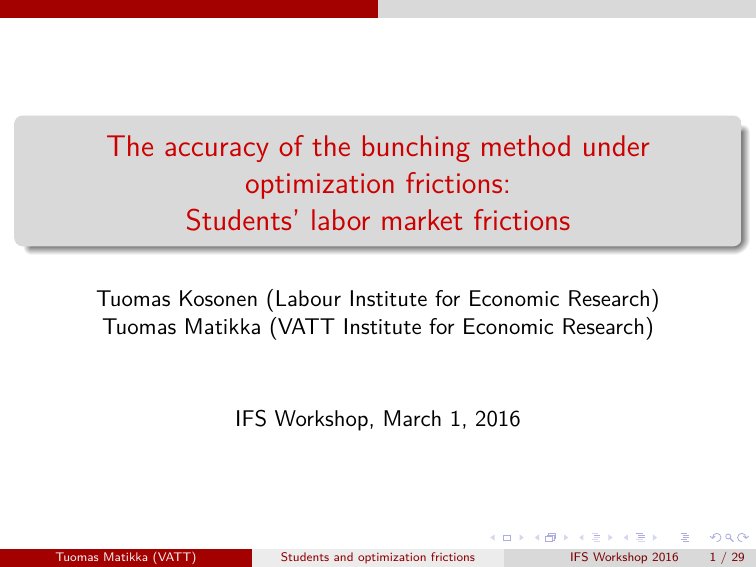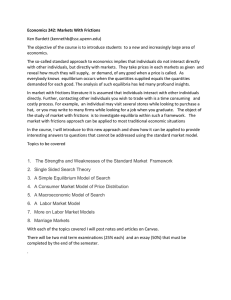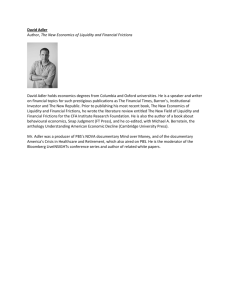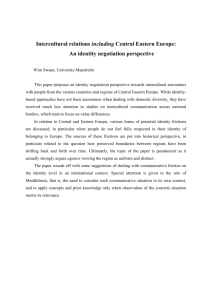The accuracy of the bunching method under optimization frictions:
advertisement

The accuracy of the bunching method under optimization frictions: Students’ labor market frictions Tuomas Kosonen (Labour Institute for Economic Research) Tuomas Matikka (VATT Institute for Economic Research) IFS Workshop, March 1, 2016 Tuomas Matikka (VATT) Students and optimization frictions IFS Workshop 2016 1 / 29 Motivation Motivation Bunching method is used to discover earnings elasticities from behavioral responses to kinks and notches (Saez AEJ:EP 2010, Bastani and Selin JPubE 2014, Kleven 2015) Relate the size of the excess mass in the income distribution to the size of tax incentives Tuomas Matikka (VATT) Students and optimization frictions IFS Workshop 2016 2 / 29 Motivation Motivation The importance of optimization frictions in attenuating responses (Chetty et al. QJE 2011, Chetty Ecta 2012, Kleven and Waseem QJE 2013) Mitigated observed bunching responses Frictions are defined as factors that affect behavior but outside of the standard labor-leisure framework Types of optimization frictions: Labor market and search frictions: imprecise control of (annual) income (Chetty et al. QJE 2011) Awareness of rules and optimization ability: lack of these attenuate responses (Chetty et al. AER 2009, Chetty et al. AER 2013, Currie and Grogger 2001 and Kleven and Kopczuk AEJ:EP 2008) Tuomas Matikka (VATT) Students and optimization frictions IFS Workshop 2016 3 / 29 Introduction Introduction Key question: How different optimization frictions affect optimization behavior and the bunching estimator? Study subsidy in Finland Applies to all higher education students (university, polytechnic) Eligibility depends on earnings: exceeding an income limit results in losing disposable income → the notch Notches create dominated regions where no one should willingly locate under any standard preferences A reform shifted out income limits Global vs. local effects of the limit Potential to disentangle different optimization frictions Tuomas Matikka (VATT) Students and optimization frictions IFS Workshop 2016 4 / 29 Introduction Introduction We find both large excess bunching and a mass of students in the dominated region Students are aware of the notch, but frictions seem to matter too The reform shifts out the whole income distribution → a global response The income limit appears to affect behavior further away from the notch (in addition to the local response) Bunching at the old notch disappears → students in general aware of the income limits Tuomas Matikka (VATT) Students and optimization frictions IFS Workshop 2016 5 / 29 Introduction Introduction Divided sample results Optimization failures and ability explain some of the nonstandard responses Suggestively, these types of frictions only attenuate local responses Tuomas Matikka (VATT) Students and optimization frictions IFS Workshop 2016 6 / 29 Institutions Marginal income tax rate schedule Marginal income tax rate schedule .2 .3 Marginal tax rate .4 .5 .6 Year 2007 0 40000 60000 80000 Taxable income Note: Marginal tax rates include the average flat municipal tax rate and average social security contributions Tuomas Matikka (VATT) 20000 Students and optimization frictions 100000 IFS Workshop 2016 7 / 29 Institutions Study subsidy Study subsidy approx. 500e per month when studying at a university or polytechnic Default: 9 subsidy months per year Max. 55 months per degree (in 2007) Eligibility depends on annual gross income: Default limit 11,800e income limit depends inversely on the number of study subsidy months applied credit points (5pts/month) In Finland, students typically work part-time during their studies Effective third-party reporting of wage income Tuomas Matikka (VATT) Students and optimization frictions IFS Workshop 2016 8 / 29 Institutions Study subsidy The notch: Exceeding the income limit results in reclaiming the subsidy of one month (with interest) Carefully monitored by the Social Insurance Institution Additional subsidy month is reclaimed per every 1,300e over the limit The reform: Income limits increased by 30% in 2008 Default 9 subsidy months: 9,200e→11,800e Tuomas Matikka (VATT) Students and optimization frictions IFS Workshop 2016 9 / 29 Institutions Study subsidy notch 9 months of study subsidy, year 2007 11100 11200 11300 11400 11500 11600 11700 Disposable income, euros Disposable income around the study subsidy notch -400 -300 -200 -100 0 100 200 300 400 Gross income relative to notch point Tuomas Matikka (VATT) Students and optimization frictions IFS Workshop 2016 10 / 29 Methods Behavioral responses to kinks and notches Under standard labor-leisure preferences, some individuals should respond to local discontinuities in their budget sets if average elasticity is significant If these responses occur, we should see individuals clustering around kinks and notches However, frictions might eliminate or mitigate observed responses In theory, frictions can be thought of as adjustment costs or fixed costs Example: small structural elasticity and large frictions → no observed responses Different (set of) frictions might lead to different patterns of responding Tuomas Matikka (VATT) Students and optimization frictions IFS Workshop 2016 11 / 29 Methods Bunching at a kink point Indiff. curves for type H (1- d;njͿ)z Indiff. curve for type L Slope 1-τ2 Slope 1-τ1 k Tuomas Matikka (VATT) k+dz Students and optimization frictions z IFS Workshop 2016 12 / 29 Methods Bunching at a notch point (1- d;njͿ)z Indiff. curve for type L Indiff. curves for type H ∆τ Slope 1-τ j Tuomas Matikka (VATT) j+∆zD j+ ∆z Students and optimization frictions z IFS Workshop 2016 13 / 29 Methods Empirical methods Bunching estimation Calculate elasticity by comparing behavioral responses from the size of the excess mass (bunching) to the incentives (Saez AEJ:EP 2010, Kleven and Waseem QJE 2013, Chetty et al. QJE 2011) Even if ETI is not correctly estimated, the bunching response is informative about behavioral responses Optimization frictions bunching response smaller than in a frictionless world → Kleven and Waseem (QJE 2013) correct for this by utilizing the mass in the dominated region True response to a notch could be more global Frictions not only attenuating bunching → We present new thoughts on extending the bunching method Tuomas Matikka (VATT) Students and optimization frictions IFS Workshop 2016 14 / 29 Methods Data Register-based data on the universe of taxpayers in Finland in 1999-2011 (at the moment student data up to 2009) Based on linked employer-employee database (FLEED) provided by Statistics Finland Data include detailed income tax and income transfer variables from official registers (Tax Administration, Social Insurance Institution) Allows for accurate analysis of bunching around different kinks and notches Tuomas Matikka (VATT) Students and optimization frictions IFS Workshop 2016 15 / 29 Results Study subsidy notch Study subsidy notch, all students Study subsidy notch, students with default subsidy (9 months) 6000 Excess mass: 1.903 (.269), Share in the dominated region: .881 (.039) Upper limit: 23 (3.24) 0 2000 4000 Frequency 2000 4000 Frequency 6000 8000 10000 12000 Excess mass: 2.046 (.227), Share in the dominated region: .906 (.032) Upper limit: 26 (4.613) -50 -40 -30 -20 -10 0 10 20 Distance from the notch Observed Tuomas Matikka (VATT) 30 40 50 -50 -40 Counterfactual Students and optimization frictions -30 -20 -10 0 10 20 Distance from the notch Observed 30 40 50 Counterfactual IFS Workshop 2016 16 / 29 Results First MTR kink, all students Last MTR kink, university/polytechnic graduates Excess mass: -.09 (.107), Elasticity: -.006(.007) Excess mass: -.106 (.084), Elasticity: -.001(.001) 2500 3000 Frequency 3500 4000 4500 5000 Frequency 5000 10000 15000 20000 25000 30000 MTR bunching for current and former students -50 -40 -30 -20 -10 0 10 Distance from the kink Observed 20 30 40 50 -50 -40 -30 Counterfactual -20 -10 0 10 Distance from the kink Observed 20 30 40 50 Counterfactual First MTR kink, students who previously bunch at the notch 1000 Frequency 2000 3000 4000 Excess mass: -.656 (.183), Elasticity: -.044(.012) -50 -40 -30 -20 -10 0 10 Distance from the kink Observed Tuomas Matikka (VATT) 20 30 40 50 Counterfactual Students and optimization frictions IFS Workshop 2016 17 / 29 Results Road map We showed that notches create behavioral responses and that optimization frictions tend to attenuate these responses Next: Global vs. local responses Utilize the reform to study the extent and shape of behavioral responses Alternative counterfactuals Divided sample results Divide students according to study credits, correlated with optimization ability Compare new and old students and rules, look into awareness about the rules more carefully Position relative to the notch prior to the reform (bunchers, dominated region) Tuomas Matikka (VATT) Students and optimization frictions IFS Workshop 2016 18 / 29 Global vs. local responses Students with 9 subsidy months in different years Income distribution in different years 0 Frequency 200 400 600 Students with 9 subsidy months and 9 subsidy months in base year 0 5000 10000 Income 2004−2005 2008−2009 Tuomas Matikka (VATT) Students and optimization frictions 15000 20000 2006−2007 IFS Workshop 2016 19 / 29 Global vs. local responses Students with 9 subsidy months in 2007 - 2008 Income distribution in different years 0 100 Frequency 200 300 400 Students with 9 subsidy months in year t and t−1 0 2000 4000 6000 8000 10000 12000 14000 16000 18000 Income 2007 Tuomas Matikka (VATT) Students and optimization frictions 2008 IFS Workshop 2016 20 / 29 Global vs. local responses Alternative shape of distribution Income distributions for students and non−students 0 1000 1500 3000 4500 Students Non−students 2500 4000 5500 6000 7000 Students: 9 subsidy months Non−students: part−time workers, aged 19−24 1500 4500 7500 Students Tuomas Matikka (VATT) 10500 Income 13500 16500 19500 Non−students Students and optimization frictions IFS Workshop 2016 21 / 29 Global vs. local responses Alternative shape of distribution: Dif-in-dif-style Income distributions for students and non−students 0 Density .00005 .0001 .00015 Students with 9 subsidy months Non−students: part−time workers aged 19−24 1500 4500 7500 10500 Labor income 13500 Students 04−05 Non−students 04−05 Tuomas Matikka (VATT) Students and optimization frictions 16500 19500 Students 08−09 Non−students 08−09 IFS Workshop 2016 22 / 29 Divided sample results Room for optimization errors? We found that some of the optimization frictions originate from the labor market and could be more global in nature Students also aware of the study subsidy system in general Any room for learning / inattention / optimization error type of frictions that attenuate behavior? These issues can be studied utilizing the local approach We next utilize study subsidy credits to investigate if some students do not fully understand all rules (although aware of them) The relevant income concept (annual gross income) How to accurately calculate and predict annual income Tuomas Matikka (VATT) Students and optimization frictions IFS Workshop 2016 23 / 29 Divided sample results Divided sample results: study credits Study subsidy notch, study credits 75−100th percentile 0 100 500 200 Frequency 300 Frequency 1000 1500 400 2000 500 2500 Study subsidy notch, study credits 0−25th percentile −50 −40 −30 −20 −10 0 10 20 Distance from the notch Tuomas Matikka (VATT) 30 40 50 −50 −40 −30 Students and optimization frictions −20 −10 0 10 20 Distance from the notch 30 40 IFS Workshop 2016 50 24 / 29 Divided sample results Utilizing the reform: new and old students and rules Study subsidy notch, new students after the reform 0 500 500 Frequency 1000 Frequency 1000 1500 2000 1500 Study subsidy notch, new students before the reform −50 −40 −30 −20 −10 0 10 20 Distance from the notch Tuomas Matikka (VATT) 30 40 50 −50 −40 −30 Students and optimization frictions −20 −10 0 10 20 Distance from the notch 30 40 IFS Workshop 2016 50 25 / 29 Divided sample results Utilizing the reform: new and old students and rules Study subsidy notch, old students after the reform 200 500 400 Frequency 600 800 Frequency 1000 1500 1000 2000 1200 Study subsidy notch, old students before the reform −50 −40 −30 −20 −10 0 10 20 Distance from the notch Tuomas Matikka (VATT) 30 40 50 −50 −40 −30 Students and optimization frictions −20 −10 0 10 20 Distance from the notch 30 40 IFS Workshop 2016 50 26 / 29 Divided sample results Bunching/dominated region before the reform Study subsidy notch, students in the dominated region before 50 100 200 100 Frequency 150 Frequency 300 400 200 500 250 Study subsidy notch, students who bunched before the reform −50 −40 −30 −20 −10 0 10 20 Distance from the notch Tuomas Matikka (VATT) 30 40 50 −50 −40 −30 Students and optimization frictions −20 −10 0 10 20 Distance from the notch 30 40 IFS Workshop 2016 50 27 / 29 Summary Conclusions Study subsidy evidence shows that incentives matter (bunching) and at the same time optimization frictions attenuate behavior (many students in dominated region) The reform evidence shows that the notch does not only induce local bunching, but also a more global shift in the income distribution The notch appears to induce behavioral responses well below the income limit Presumably, ETI is not calculated correctly by just utilizing local bunching estimates This, and the disperse bunching, also indicate that taxpayers have difficulties in controlling their income precisely Optimization ability also prevalent in explaining behavioral responses Correlation between study credits and optimization behavior Use data on secondary school test scores in the future Tuomas Matikka (VATT) Students and optimization frictions IFS Workshop 2016 28 / 29 Summary Thank you for your attention! Tuomas Matikka (VATT) Students and optimization frictions IFS Workshop 2016 29 / 29



